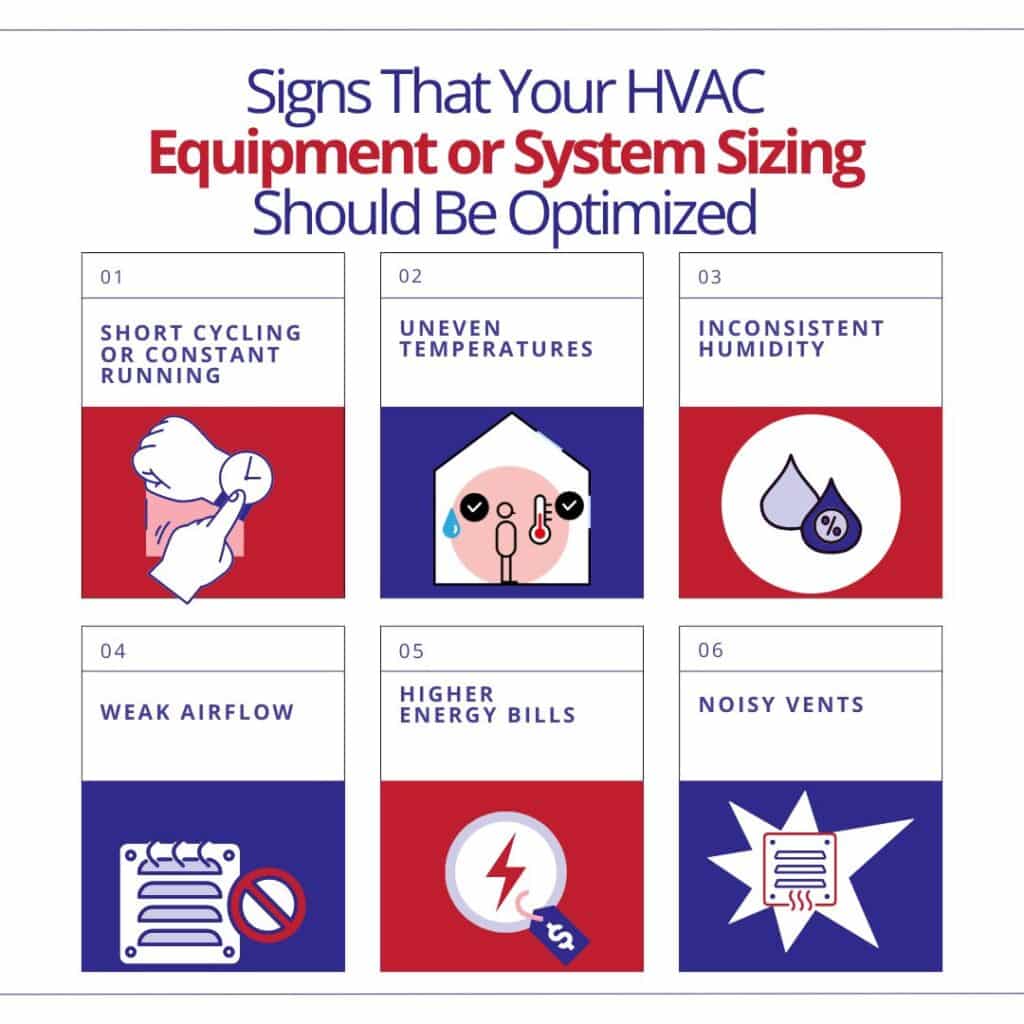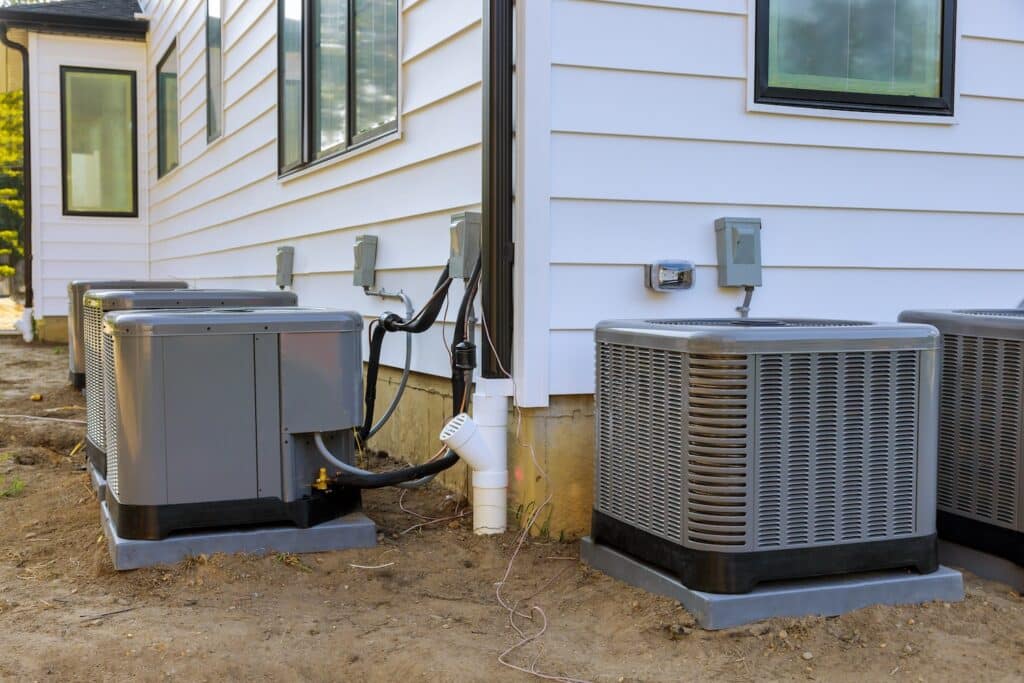Your HVAC system should effectively heat and cool your home without wasting energy or breaking down. But when the equipment or ductwork isn’t the right size, you’ll notice problems. Sizing for HVAC equipment matters more than most homeowners realize for preventing issues.
When done right, it helps your HVAC system work efficiently and keeps your home consistently comfortable. This article explains the most common issues caused by improper sizing and how they’re best avoided.
What Do We Mean By Improper Sizing?
Improper sizing happens when the HVAC equipment (such as the furnace or air conditioner) or the ductwork isn’t matched to your home’s needs.
Bigger isn’t always better, and smaller isn’t cheaper in the long run. HVAC sizing should account for factors like your home’s square footage, insulation levels, number of windows, and even your local climate.
Equipment sizing is based on how much heating or cooling power (measured in BTUs or tons) your system provides. An oversized unit may heat or cool too quickly, while an undersized one may run constantly without reaching the desired temperature.
Ductwork sizing refers to the width and layout of the air ducts that distribute heated or cooled air. Ducts that are too narrow, too wide, or poorly designed can lead to airflow problems and uneven temperatures.
If the calculations or selections are managed improperly for your system, you’ll notice some (or all) of the issues we’ll discuss below.

Issues From Improper Equipment Sizing
An HVAC system that isn’t sized properly can cause a range of problems affecting comfort, efficiency, and long-term performance:
- Short Cycling: Oversized systems cool or heat your home too quickly, causing them to turn on and off repeatedly. This wastes energy, increases wear on components, and shortens the system’s lifespan.
- Constant Running: Undersized systems often run non-stop trying to reach the set temperature. This leads to higher energy bills and faster wear and tear.
- Uneven Temperatures: Some rooms may stay warm while others feel chilly. Improperly sized equipment can’t distribute air evenly, making certain spaces uncomfortable.
- Poor Humidity Control: Oversized units don’t run long enough to remove excess humidity, while undersized ones may struggle to cool and dehumidify effectively.
- Frequent Repairs and Early Replacement: Systems that work too hard or cycle too often endure more stress, leading to frequent breakdowns and a shorter lifespan.
Issues From Improperly Sized Ductwork
Even with the right equipment, ductwork that’s the wrong size can cause significant HVAC issues, including:
- Weak Airflow: Ducts that are too small restrict air movement, making it harder for air to reach certain rooms.
- Uneven Heating and Cooling: Incorrect duct sizing prevents even air distribution, causing temperature inconsistencies throughout your home.
- Higher Energy Bills: Your HVAC system has to work harder to push air through poorly sized ducts, increasing energy use and costs.
- Noisy Vents: Air rushing through ducts that are too narrow can create whistling or rattling noises.
- Premature Wear on Equipment: Constant strain from improper airflow can lead to equipment breakdowns and early replacement.
How Professionals Prevent These Issues
Preventing HVAC sizing issues isn’t guesswork—it requires precise calculations and planning. Professionals use industry-standard methods to ensure your system fits your home’s unique needs:
- Manual J Load Calculation: Determines the exact heating and cooling requirements based on factors like square footage, insulation, window placement, and local climate. This ensures the HVAC system isn’t too large or too small.
- Manual D Duct Design: Ensures the ductwork is properly sized and laid out to deliver balanced airflow throughout the home. Well-designed ducts improve comfort and energy efficiency.
- Manual S Equipment Selection: Matches the right equipment to your home’s calculated needs, ensuring the HVAC system operates efficiently and lasts longer.
Working with professionals who use these calculations helps avoid unnecessary costs, improves comfort, and extends the life of your HVAC system.

Other Ways to Keep Your HVAC System Running Smoothly
Beyond proper sizing, regular maintenance plays a vital role in preventing HVAC issues. These simple steps can improve performance and reduce the risk of future problems:
- Schedule regular inspections to catch potential issues early.
- Replace air filters regularly to maintain good airflow and reduce strain on the system.
- Monitor your energy bills and comfort levels—sudden spikes or uneven temperatures may signal underlying problems.
- Keep vents and ducts clean and unobstructed to promote efficient airflow.
When to Ask a Pro
If you notice any of the following, it may be time to consult a professional:
- Rooms that never reach the desired temperature
- Unexpected increases in energy bills
- Frequent system cycling or nonstop running
- Unusual noises from vents or the HVAC unit
- Persistent humidity problems or poor indoor air quality
KO Inspections offers expert evaluations to identify and address HVAC sizing issues. Their team provides accurate load calculations, duct design, and equipment selection services to ensure your system is properly tailored to your home.
Conclusion
Improperly sized HVAC equipment or ductwork can cause uncomfortable rooms, higher energy costs, and premature system failure.
If your HVAC system isn’t performing as it should, KO Inspections can help. Our professional services and calculations ensure your entire system is sized perfectly for lasting efficiency.

